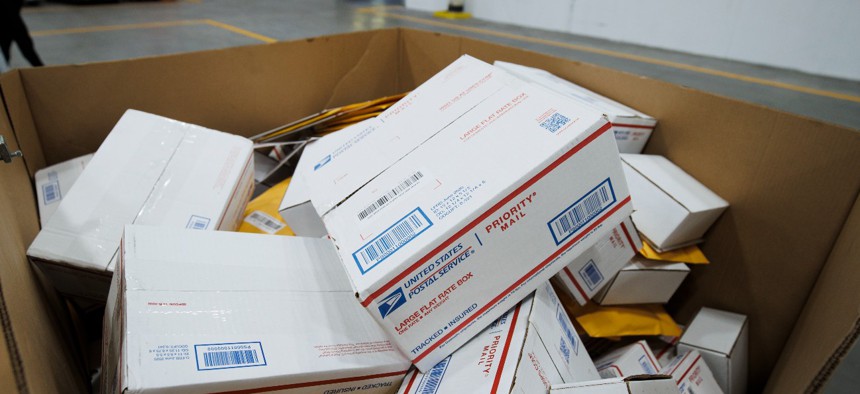
USPS should ensure it has taken customer input into account and relied upon reasonable assumptions as it seeks to ensure faster delivery for items sent through its Retail Ground and Parcel Ground Select offerings, regulator says. Brett Carlsen/Getty Images
Regulator Warns That More Elements of DeJoy's Plan for USPS Are Disruptive and Unrealistic
In this case, the Postal Service is seeking to deliver some packages more quickly.
The U.S. Postal Service’s regulator said on Thursday the mailing agency’s plan to speed up delivery for some of the packages it ships could be costlier, require more staffing and drive fewer efficiencies than management has estimated.
USPS should go back to the drawing board to ensure it has taken customer input into account and relied upon reasonable assumptions as it seeks to ensure faster delivery for items sent through its Retail Ground and Parcel Ground Select offerings, the Postal Regulatory Commission said in its advisory opinion. Customers can use those products to send packages that weigh between one and 70 pounds, which currently arrive between two and eight days after they are sent. Under the new proposal, the Postal Service plans to deliver the packages within two-to-five days. It does so with just 40% of those packages in the existing system.
The proposal is part of Postmaster General Louis DeJoy’s 10-year business plan to bring the agency out of the red and is coupled with the recent implementation of his change to slow down delivery for the lighter weight First-Class packages. By bringing the three types of packages into the same two-to-five day window, USPS said it can streamline its operations so it fills up its trucks to capacity and requires less handling throughout the delivery process. Postal management said the change would bring a low-cost, medium-speed option to its customers, which is not currently part of its portfolio despite it being offered in the private sector. Costs to the agency would not change significantly, USPS said.
While the Postal Service can generally do what it wants with its competitive products like packages, it had to submit the plan to PRC for a non-binding advisory opinion. PRC questioned postal management’s assumptions, saying it did not provide evidence that any near-term efficiencies would be realized. It praised USPS for seeking to improve service, saying such an outcome would be in the interest of mailers and the public good, but added the agency failed to demonstrate when any anticipated benefits would materialize. The heavier packages could require more personnel and take longer to process, PRC predicted, which could lead to slower delivery across the system.
The Postal Service said it would initially rely on more air transportation to deliver the packages faster, but will phase that out over time. PRC noted it failed to demonstrate that would lead to efficiencies, or that it could implement its plan operationally, maintain consistency over time, actualize its models in reality or avoid cannibalizing its existing offerings. Postal management assumed the faster delivery would lead to more volume, but the commission said it did not support that claim. It did not conduct sufficient research with its customers to support its assumptions, the regulator said, calling its market research inadequate.
USPS countered that it interviewed industry leaders and experts, and surveyed e-commerce businesses. Still, PRC said the Postal Service’s plan “could lead to disruptions in processing and transportation operations and cost increases.”
The Postal Service implemented its slowdown for First-Class package delivery last month over PRC's objections. The regulator last year similarly blasted the agency for failing to demonstrate it could implement its operational plan, provide consistent and reliable service or achieve its anticipated efficiencies. Postal management leaned on oversimplified assumptions and predicted outcomes “potentially inaccurate and unachievable,” the commission said. It added USPS failed to analyze the impact of its changes on customers and challenged the proportion of packages that would be affected.
While postal management ignored PRC’s suggestions last time around, the regulator put forward a series of recommendations including calling on the agency to create a detailed timeline of when each of the reforms in DeJoy’s plan will be implemented and how each step would contribute to the assumed improvements. It also called for better oversight so USPS can learn lessons along the way, and said management should create a plan to measure the impact on users and other mail. The suggestions once again carried no enforcement mechanism.







